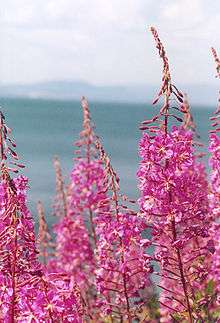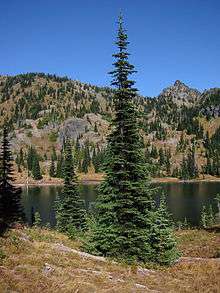Symbols of Yukon

Yukon is one of Canada's territories, and has established several territorial symbols.[1]
Official symbols
| Symbol | Image | Adopted | Remarks | |
|---|---|---|---|---|
| Coat of arms | Coat of arms of Yukon |  |
1956 | It was approved officially by Queen Elizabeth II |
| Flag | Flag of Yukon | |
March 1, 1968 | |
| Shield of arms | Shield of arms of Yukon | .svg.png) |
1956 | Granted with other elements of the coat of arms |
| Floral | Fireweed (Epilobium angustifolium) |
 |
1957 | |
| Tree | Subalpine fir (Abies lasiocarpa) |
 |
2001 | The sap drawn from the blisters on its bark has been used by First Nation people as a traditional medicine for lung ailments. |
| Bird | Raven (Corvus corax) |
 |
1985 | The raven is seen everywhere in Yukon. Raven is called "crow" by Yukon First Nations people. |
| Gemstone | Lazulite | |
February 1976 | Lazulite is found in the layered sedimentary rock of the Blow River area in Ivvavik National Park. The colour and crystalline qualities of Yukon's lazulite are among the finest in the world. |
| Tartan | Woven cloth that is composed of green, dark blue, magenta, yellow and white stripes in varying widths on a light blue background. | 1984 | ||
References
- ↑ Government of Yukon. "Symbols of Yukon". Retrieved 2008-04-09.
This article is issued from Wikipedia - version of the 9/4/2016. The text is available under the Creative Commons Attribution/Share Alike but additional terms may apply for the media files.